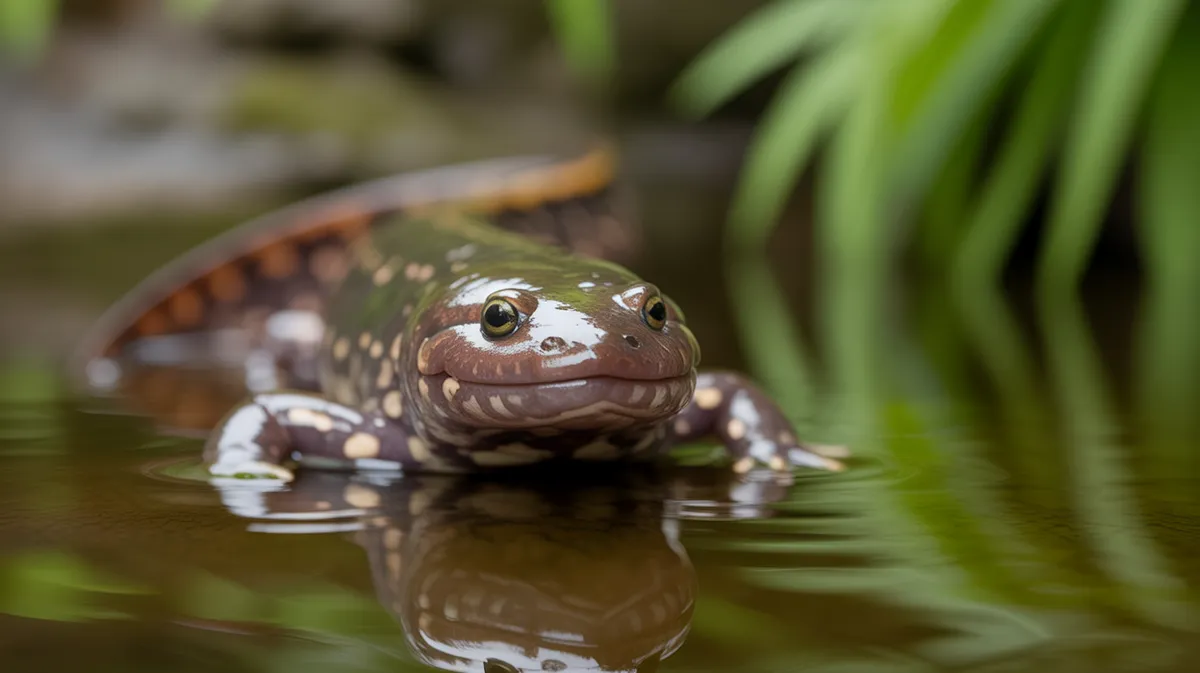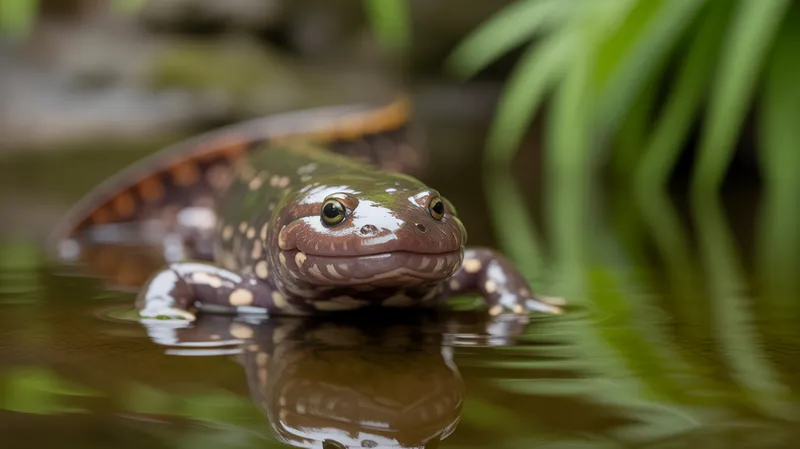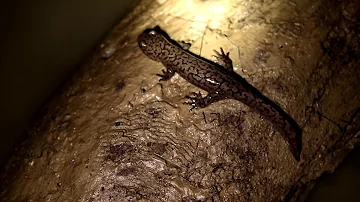
Coastal Giant Salamander
Dicamptodon tenebrosus

Meet the Coastal Giant Salamander
The Coastal Giant Salamander is the largest terrestrial salamander in North America, reaching lengths of up to 34 centimeters. It is notable for its robust body, broad head, and distinctive marbled or mottled brown and tan coloration. This species is semi-aquatic, spending its larval stage in cool, fast-flowing streams and transitioning to life on land as an adult, although some individuals remain aquatic for life. The Coastal Giant Salamander is found primarily in moist coniferous forests of the Pacific Northwest, where it hides under logs, rocks, and leaf litter.
Classification
Amphibian
Habitat
Cool, fast-flowing mountain streams and moist forested areas
Diet
Carnivore
Lifespan
10-25 years
Conservation
Near Threatened
Weight
60-200 grams
📖Fascinating Facts
Forest Dwellers
These salamanders thrive in old-growth and mature forests, relying on cool, shaded streams for breeding and larval development.
Strong Jaws
Their powerful jaws allow them to feed on a variety of prey, including insects, slugs, small fish, and even other amphibians.
Vocal Abilities
Unlike most salamanders, the Coastal Giant Salamander can make a barking sound when disturbed, which may deter predators.
📋Detailed Description
The Coastal Giant Salamander (Dicamptodon tenebrosus) is a robust, heavy-bodied amphibian and the largest terrestrial salamander in North America, with adults typically reaching 17–34 cm in total length. Its broad, flattened head, muscular limbs, and laterally compressed tail are well-adapted for both aquatic and terrestrial life. The skin is granular and moist, exhibiting a distinctive marbled pattern of brown, tan, and sometimes purplish hues, providing camouflage among streambed rocks and forest detritus. The species possesses well-developed costal grooves along the body, aiding in moisture retention. Larvae are fully aquatic, displaying bushy external gills, a pronounced tail fin, and a pale belly, while terrestrial adults lose their gills and develop lungs for breathing air. Some individuals exhibit neoteny, retaining larval features and remaining aquatic throughout life. The species has a large, wide mouth equipped with numerous small, sharp teeth suited for grasping prey. Eyes are relatively large with well-developed eyelids, enhancing vision in dim, forested environments. The Coastal Giant Salamander is primarily nocturnal, emerging at dusk to forage and retreating to moist refuges during the day.
💡 Did you know?
Some Coastal Giant Salamanders never leave the water, remaining in their larval form with external gills for their entire life—a phenomenon known as neoteny.
🔬Research & Sources
Wikipedia Summary
The coastal giant salamander is a species of salamander in the genus Dicamptodon. It is endemic to the Pacific Northwest of North America. There are three closely related species to this taxon: D. ensatus, D. copei, and D. aterrimus.
Last Modified: 5/23/2025
🎭Behavior & Social Structure
Coastal Giant Salamanders are solitary and secretive, spending most of their time hidden under rocks, logs, or within burrows near streams. They are primarily nocturnal, emerging at night to hunt. Their diet consists mainly of aquatic and terrestrial invertebrates (such as insects, worms, and snails), but adults are known to prey on small vertebrates, including other salamanders, frogs, and occasionally small mammals. They employ a sit-and-wait (ambush) hunting strategy, remaining motionless until prey approaches. When threatened, they may produce a barking or croaking vocalization, rare among salamanders, and can deliver a painful bite if handled. Territoriality is not strongly developed, but individuals may defend prime hiding spots. During dry or cold periods, they enter a state of torpor underground or in moist microhabitats.
👶Reproduction & Life Cycle
Breeding occurs in late winter to early spring, typically from February to May, depending on elevation and local climate. Courtship involves a series of tactile and chemical cues, with the male guiding the female over a deposited spermatophore, which she picks up with her cloaca. Females lay 50–200 eggs in moist, protected sites such as crevices under submerged logs or rocks in streams. The eggs are attached in grape-like clusters and guarded by the female for several months, a rare example of parental care among salamanders. Embryonic development lasts 5–7 months, with hatching timed to coincide with optimal stream conditions. Larvae remain aquatic for 1–3 years before undergoing metamorphosis, though some may remain neotenic and reproduce without metamorphosing.
🛡️Adaptations & Survival
Dicamptodon tenebrosus exhibits several adaptations for its dual aquatic-terrestrial lifestyle. Its granular skin and costal grooves facilitate cutaneous respiration and moisture retention, critical for survival in variable humidity. The species can absorb oxygen through both skin and lungs, and aquatic larvae possess large external gills for efficient underwater respiration. The marbled coloration provides effective camouflage in dappled forest light and among stream substrates. Behavioral adaptations include nocturnality to avoid predation and desiccation, and the ability to vocalize as a deterrent. Neoteny allows populations to persist in permanent aquatic habitats where terrestrial conditions are unsuitable. The species also secretes mild toxins from skin glands, deterring some predators.
🎨Cultural Significance
The Coastal Giant Salamander is not widely featured in indigenous mythology or folklore, but salamanders in general have been associated with water spirits and transformation in Pacific Northwest cultures. In modern times, it serves as an indicator species for healthy forest and stream ecosystems, and is sometimes referenced in environmental education and conservation programs. Its unique vocalizations and large size make it a subject of interest for naturalists and herpetologists.
🔬Recent Research & Discoveries
Recent research has focused on the genetic structure and phylogeography of Dicamptodon species, revealing historical patterns of isolation and hybridization with closely related taxa. Studies have examined the effects of forest management practices on salamander abundance and stream health, highlighting the importance of riparian buffers. Ongoing work investigates the species' role in nutrient cycling and as a top invertebrate predator in headwater streams. Conservation genetics is an active area, with efforts to monitor population connectivity and resilience to environmental change. The species' neotenic forms are also of interest for studies on amphibian development and evolutionary biology.
🎥Wildlife Videos

Night of the Salamander - The Secrets of Nature
The film reveals all the miracles and curiosities in the salamander world that, until now, were only known to a few experts in the ...
Go Wild

CH5 - Nature Documentary - Japan's Wild Waters: Giant Salamander (1999)
Dive into the mesmerizing world of "Japan's Wild Waters: Giant Salamander," a captivating documentary that unveils the hidden ...
EarthBound 104

Giant Salamanders: The River Dragon
----------- SOCIAL MEDIA https://www.instagram.com/animalogicshow/ https://twitter.com/animalogicshow ...
Animalogic

coastal giant salamander
At least I think that's what this critter is... my first time finding one. Lovely brown & gold paisley patterning. Spotted him inside the ...
Will Interest

Coastal Giant Salamander in Northern California
I found this coastal giant salamander in the redwoods some time ago. A stunning specimen he was living a peaceful life far from ...
Dub Paetz

Chinese giant salamander (mini documentary)
Come with me to meet the Chinese giant salamander.. Thank you very much for watch! #salamander #giantsalamander.
Awesome Animals
🌍Habitat Information
The Coastal Giant Salamander typically inhabits Cool, fast-flowing mountain streams and moist forested areas environments. Coastal Giant Salamanders have adapted to their environments with specialized features and behaviors.
Primary Habitat:
Cool, fast-flowing mountain streams and moist forested areas
More detailed habitat information will be available soon.
🛡️Conservation Status
The Coastal Giant Salamander is currently classified as Near Threatened. Conservation efforts are crucial for preserving this species for future generations.
Common Threats:
- 🏠Habitat loss and fragmentation
- 🌡️Climate change impacts
- 🎯Hunting and poaching
- 🏭Human-wildlife conflict
⚠️Threats & Conservation Challenges
While currently listed as Least Concern by the IUCN, the Coastal Giant Salamander faces localized threats from habitat loss due to logging, urban development, and stream alteration. Siltation and pollution from forestry operations degrade breeding streams, while road construction fragments populations. Introduced predators such as fish can prey on larvae. Climate change poses a long-term threat by altering stream flow regimes and increasing the frequency of droughts. Although populations remain stable in protected areas, declines have been noted in heavily managed forests. Disease, particularly chytridiomycosis, is a potential but not yet documented threat.
🔬Scientific Classification
Scientific Name
Dicamptodon tenebrosus
Classification Hierarchy
🔍 About Taxonomic Classification
Taxonomic classification is a hierarchical system used by scientists to classify and organize living organisms based on shared characteristics and evolutionary relationships.
The system moves from broad categories (Kingdom) to increasingly specific ones, with each animal's scientific name typically consisting of its Genus and species.
📝Community Notes
Share your observations and insights about the Coastal Giant Salamander with our community of wildlife enthusiasts.
Join Our Community
Sign in to share your observations and connect with fellow wildlife enthusiasts.
Sign In to ContributeNo community notes yet
Be the first to share your observations about the Coastal Giant Salamander!
Explore Coastal Giant Salamander
Select a tab above to learn more about this amazing animal.
📸Photo Gallery
No photos available for this animal yet.
🌟Discover More Wildlife
Continue your journey of discovery with more fascinating animals from our database
